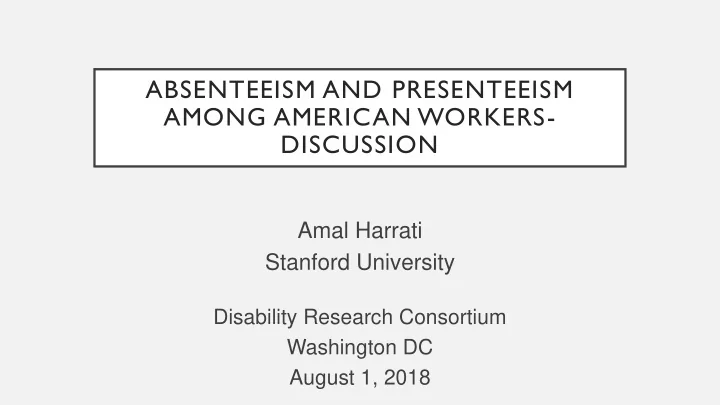

ABSENTEEISM AND PRESENTEEISM AMONG AMERICAN WORKERS- DISCUSSION Amal Harrati Stanford University Disability Research Consortium Washington DC August 1, 2018
SUMMARY • Objective: Estimate absenteeism and presenteeism rates for American workers; how is it related to health conditions? Estimate whether absenteeism patterns predict labor market outcomes three years later. • Data: American Working Conditions Survey 2015, 2018 (n=~2,000) • Exposure: Absenteeism, Presenteeism, Health Conditions • Outcome : Labor Market Outcomes three years later • Method: Descriptive statistics, regression models
FINDINGS AND CONTRIBUTIONS 1. First nationally-representative estimates of absenteeism 2. Specific data on health conditions, labor market conditions, occupation and income, demographics 3. High level of absenteeism is related to later disability and higher likelihood of not working 4. Serious health conditions, including depression, are related to later disability and higher likelihood of not working
DISCUSSION POINT: ARE ABSENTEEISM AND PRESENTEEISM A BUNDLE OR SUBSTITUTES? • Presenteeism is predictive of absenteeism but absenteeism is not predictive of presenteeism • Age effects of presenteeism? Is this attrition? • Can we trust self-reports of productivity loss?
DISCUSSION POINT: DOES YOUR JOB MAKE YOU SICK OR ARE YOU SICK OF YOUR JOB? • The role of specific occupations and industry • What is the role of personality? • Can we measure labor force attachment?
DISCUSSION POINT: WHAT IS THE ROLE OF SICK LEAVE? WILL INCREASING SICK LEAVE POLICIES HELP? • Presenteeism is higher among those with sick leave • Different occupations have different financial incentives to work • The nature of the disease (chronic versus acute) likely matters
DISCUSSION POINT: WHAT IS THE ROLE OF TIME? • Three years may be long enough for workers to adjust • What if absenteeism is on the pathway from health to disability?
Recommend
More recommend